The last, best bastions for French collector cars in North America

For those not from North American enclaves where French influence remains vibrant, the phrase “defiantly French” may require some context. In a continent where English and Spanish largely won the language wars, this shorthand refers to the ongoing struggle to preserve an endangered heritage rooted in French identity. These regions have for centuries successfully fused native and French cultures, culminating in a series of traditions, dialects, and cuisine all their own. Despite having long since relinquished its claims on the North American continent, France’s contributions still represent a vital ingredient to it all. La farine dans le roux. The flour in the roux.
While these regions have continued to evolve over time, we wondered if a certain joie de vivre still exists in the classic car communities of the former New France (inclusive of lower Québec, northern New Brunswick, and southern Louisiana). Are Montreal and New Orleans still your best bets this side of the Atlantic for spotting the rare North American Citroën 2CV?
French Car Companies take on North America
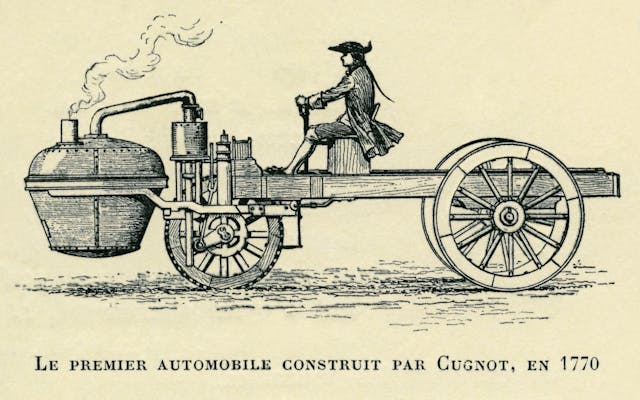
The first automobile was French. Or at least, the first “self-propelled vehicle.” In 1769, a French military engineer named Nicolas-Joseph Cugnot built his “fardier à vapeur” (or “steam cart”) for the army as a means to transport cannons. This early innovation proved influential, and for most of the 19th and very early 20th centuries the country was an unchallenged leader in the advancement of the car industry: the 1800s in France saw the development of various versions of the internal combustion engine, the first gasoline powered automobile, and the founding of both Peugeot and Renault. By the early 1900s, France produced more cars than the rest of Europe put together, and it wasn’t until 1907 that the industry in the US caught up and began to outpace the much smaller country.
With such an early advantage, it’s strange that French cars have never been able to make a dent in the enormous Canadian and American car markets, collector or otherwise. It wasn’t for lack of effort, either: Citroën and Renault both made significant drives to reach North American consumers beginning in the late 1940s. While Citroën was ultimately unable to survive the 1960s and ’70s and the phenom that was the Volkswagen Beetle—or the resulting U.S.-produced competitors—Renault managed to persist up through the excess of the mid-1980s.
The latter brand was arguably the best at adapting, moving between impressive sales of the small, affordable Dauphine in the late 1950s, to the larger and more luxurious 16 in the late 1960s, and back to the more compact and fuel-efficient 5 (or LeCar) in the oil crisis-laden mid 1970s with admirable agility. Renault even bought a controlling stake in the financially endangered American car company AMC in 1980, and began manufacturing the Alliance and Encore in Wisconsin. Unfortunately, the cars quickly gained a fatal reputation for unreliability right when Renault faced a new, unbeatable foe: the affordable, dependable Japanese compact. Renault was no match for the million-mile motor, and when Georges Besse, Renault’s CEO and a crucial advocate for the U.S. business, was tragically murdered by terrorists in 1986, the company soon sold its AMC stake to Chrysler.
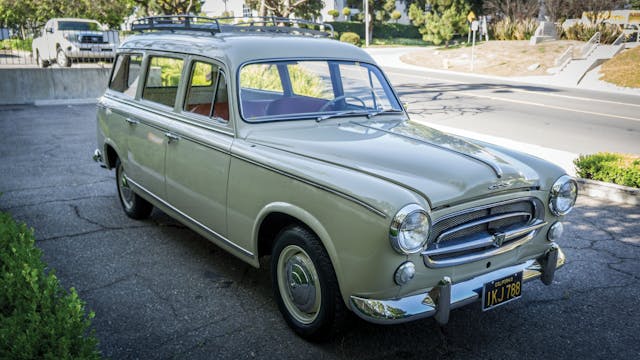
The last of the French big three, Peugeot, also put forth a valiant effort. Though they were late to the game, only officially starting to import the 403 to the U.S. in 1958, the company got off to an impressively solid start and wisely made no attempts to directly compete with the unstoppable Beetle. On the flip side, Peugeot was also very slow to react to changes in the market. Though it got lucky with the boom in popularity of luxury imports in the 1980s, riding the yuppie wave with the 505 to an American sales peak in 1984, this surge of success dropped off the longer the model was out. Peugeot didn’t release the well-crafted 405 in the U.S. until 1989, at which point it was too little, too late. By August of 1991, Peugeot had pulled out of the market, signaling the official end of the French car industry in both the United States and Canada.
So, if you were a Canadian or American Francophile who snagged a driver’s license in the 1990s or later, the option to buy new and to buy French was nonexistent; and while those born earlier did have the option available, it was never widely so. Both countries have also maintained strict import rules (fifteen years for Canada and twenty-five for the U.S.) that have made securing newer models a practice in supreme patience. It’s probably safe to say that in both Québec and New Orleans, you likely weren’t growing up with a Citroën as your family car. The basis for any affinity towards French cars this side of the Atlantic would likely rest more on aspiration than nostalgia.
Je me souviens … The Citroën
The French first started colonizing North America in and around what is today known as the St. Lawrence River in the early 1500s, though it wasn’t until 1608 that one of the first permanent settlements was founded in Québec City. The city’s settlers came from the northwestern coastal and urban regions of France, and experienced a high rate of cultural exchange with First Nations communities while strongly resisting the crown’s attempts to impose any manner of a traditional feudal society.
This defiant streak remained a signature component of the French Canadian colonies, even as their new opponent became the ever-growing British presence on the continent. Though France eventually ceded New France to Great Britain, the Québec Act of 1774 guaranteed the province freedom to preserve the existing French law, language, and religion. While the struggle for cultural preservation and autonomy certainly didn’t end there for French Canadians, it set up the foundation of a separate identity and the strong desire to be Maîtres chez nous, or “Masters of our own house.”
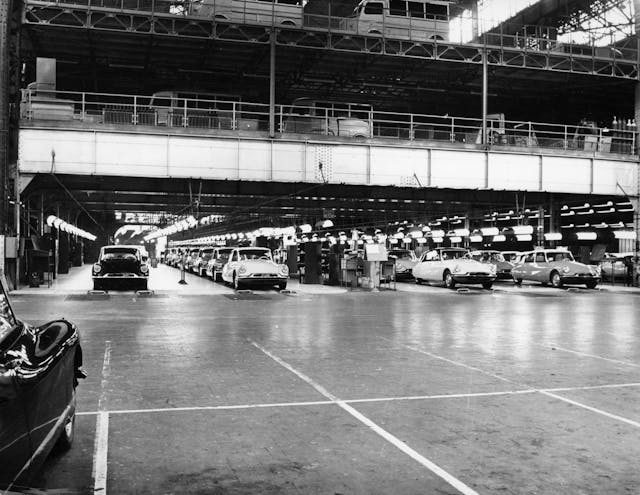
Today, over 77 percent of Québec residents consider French to be their mother tongue, and it is still the singular official language of the province. Roughly the same percent still identify as Catholic, the religion of the early French settlers. Saint-Jean-Baptiste Day is also one of the largest holidays in the region, a festival that dates back to 18th century France and has recently become a rallying point for some separatist movements. But does this desire for a clear, distinct identity extend to their cars? It’s certainly not a guarantee, given that the aforementioned cars are French, and not French Canadian; built in a modern era centuries after the official ties had been cut.
The impetus for digging into the classic car communities of the former New France actually came from a finding in Hagerty’s data that Québec insures French vehicles at over 7 times the rate of the rest of Canada. While this only amounts to 1.25 percent of the total classic cars insured in the province, it is still a significant portion for a subspecies of antique vehicle that remains exceedingly rare in most of North America when compared to its Italian, German, British, American, and Japanese counterparts.
See that darker spot in Montana? Bugattis and favorable tax laws go together like sauvignon blanc and soft cheese. But Québec's French car love is the obvious standout. It even bleeds over a bit into neighboring Vermont and Maine.
The contrast is at least stark enough to be worth taking note of for French car fanatics. Though, it does matter which type of French cars you love. The answer to our specific question above, with regard to the Citroën 2CV, is a resounding “yes” as far as Montreal is concerned. In fact, Citroën utterly dominates the French Canadian scene, accounting for a massive 73% of the French cars insured by Hagerty in Québec. And the 2CV is the most popular of Citroën’s cars in the area, representing roughly 32 percent of the total volume all on its own.
Often deemed a “car of the people”, a term also reserved for the aforementioned Volkswagen Beetle and iconic Mini Cooper, the omnipresence of the 2CV isn’t all too surprising. Though not considered remotely sexy at the time, the vehicle was designed to be all of the things we’ve since learned imbue a car with an enduring fanbase: affordable, minimal, and practical. And while its reputation as a slow-poke also endures - the first generation only reached a top speed of 40mph in about 42 seconds—the impressive 64 mpg of the original air-cooled, 375-cc, two-cylinder engine makes it worth it for many collectors, especially those comfortable with a more leisurely pace on their morning drives (thrill-seekers may still be satisfied with the manufacturer’s “weeble-wobble” effect—Citroën’s tip, but they don’t tip over).
But according to André Verner, there’s another contender for “Most Iconically Quebec:” the Citroën DS. André is the General Manager of the Elegance Trois-Rivieres, a new Concours d'Elegance event premiering in late-July of 2022 that aims to be the Pebble Beach of French Canada. In the spirit of full transparency, André may also be a little biased. He’s been the proud owner of the same DS for roughly 52 years, having bought it originally in 1971 and lovingly cared for it ever since; a commitment which included never driving it in the infamous Canadian winters.
But can you blame him? It was love at first sight. He was at the Montreal International Car Show with his French brother-in-law when they noticed a long line forming to sit in one particular car. So they waited. And waited. And when it was finally their turn, they were presented with the 1971 DS, an experience André describes as “overwhelm[ing].” The next Monday morning, he was at the St. Catherine Street dealership in Montreal, and bought the last ‘71 they had.

And from the very beginning, he’s been strengthening his defense for the DS. When his neighbors saw the odd looking contraption he’d replaced his 1968 Ford Mustang GT with, they blatantly asked why he’d bought such an ugly car. “Just wait a few years,” was André’s response, “and it won't be ugly anymore.” To his credit, he’s been largely correct. The DS has since been treasured with what can only be described as an ardent fervor by the classic car community, who have bequeathed it with such labels as “divine”, “a decade ahead of its time”, and even “a goddess.”
André also believes that the popularity of Citroëns is currently growing in the region, largely due to the increased visibility from auction sites. He notes, “... there are Citroëns practically every week now on Bring a Trailer,” which he believes has helped revive cross-generational interest. He even has numerous friends currently going through the extra effort to import the vehicles directly from France and Italy.
As to why the increased love for French cars in Québec? André agrees that the shared language may be a factor. But he pointed to another idea, too: people were impressed with the spectacular technology and innovative design back in the early 70s, just before the company pulled out of the North American markets. Many of the kids who would have ogled at the car shows alongside André probably still retain fond memories of the futuristic, yet attainable marvel, only amplified by the unrequited nature of their longing. For a region that historian and journalist Colin Woodard describes as simultaneously “[d]own-to-earth”, “extremely open-minded,” and one of the most “postmodern” cultures this side of the Atlantic, it’s a match made in paradis.
Cars and Coffee
As for Southern Louisiana, the chief bastion of Frenchness this side of the Great Lakes, the data doesn’t seem to point to any clear trends. There are many possible explanations as to why, including an aggressive campaign to Anglicize the region and a French history that starts and ends long before cars were even a twinkle in Monsieur Cugnot‘s eye.
After a series of persecutions, expulsions, and “relocations” at the hands of the British in the mid-1700s, a group known as the Acadians (originally French peasants from more pastoral regions) ultimately made their way from eastern Canada to present-day Southern Louisiana, morphing into the Cajuns. By this point, New Orleans had also already been around for decades, serving as a valuable port for King Louis XV and a Creole cultural stronghold, with a population characterized by its mixed and diverse ancestry. New Orleans is undeniably just as African, Caribbean, Spanish, and Native American as it is French.
But French symbolism, like the iconic Fleur de Lis, has often been a shared way in which the city and surrounding areas differentiate their distinct heritage and, most importantly, vibe, from the rest of the country. Unfortunately, Louisiana never had a legal protection akin to the Québec Act, and a state constitution established in 1921 and lasting roughly 50 years mandated English as the only language for instruction in schools. Though an organization dedicated to preserving the Louisiana French dialects was formed in the 1960s, much damage had already been done. As of the 2000 census, only around 3% of the state’s population spoke primarily French.
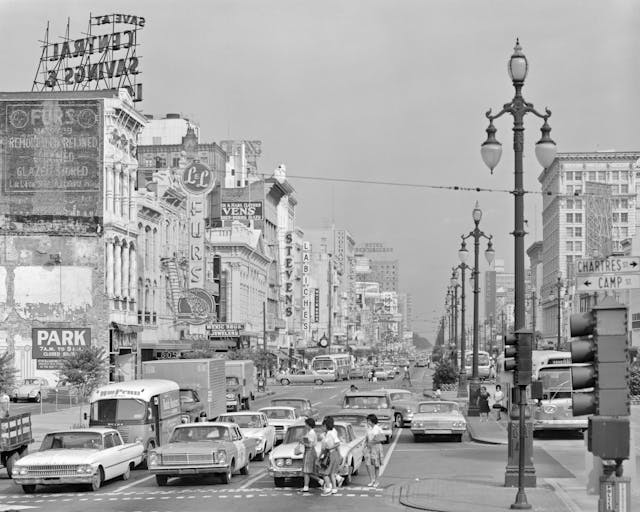
On the bright side, other aspects of the Franco-influenced cultures, such as the infamous Mardi Gras and the sublimely fantastic cuisine, have fared far better. And it is in this latter arena where classic French cars are really starting to make their mark in the Big Easy.
N7, a critically lauded French restaurant and wine bar, opened in the Bywater neighborhood in late 2015. As their website explains, the establishment is named after what used to be a French equivalent to Highway 1, Nationale 7, that ran from Paris to Italy. There’s even a map of the old route on the menu, tracing its way seductively through Lyons and Nice, as well as a late 1960s maroon Citroën DS parked proudly out front.
The coffee scene has also cleverly hopped on the Citroën wagon. Petit Rouge, a roaming coffee spot operating out of a bright red 1970 Citroën H-Van, was featured in a Hagerty video centered around a French expat who always makes time for cruising around the city in his 1961 Citroën 2CV. One of the most beloved coffee brands in the area has even put it right there in the name.
Geoffrey Meeker, founder and owner of French Truck Coffee, grew up admiring classic cars, and remembers one experience in particular as being formative on his journey to the iconic image that now emblazons all of his cafes: “When I was growing up my best friend's father bought a 1961 Jaguar E-Type on a whim during a road trip. It was the coolest thing on four wheels that I had ever seen. The lines, the headlights, the rumble of the engine… The curves of the E-Type that I loved as a kid got me interested in the Citroën DS. The technology that was wrapped up in that styling was really intriguing to me.”
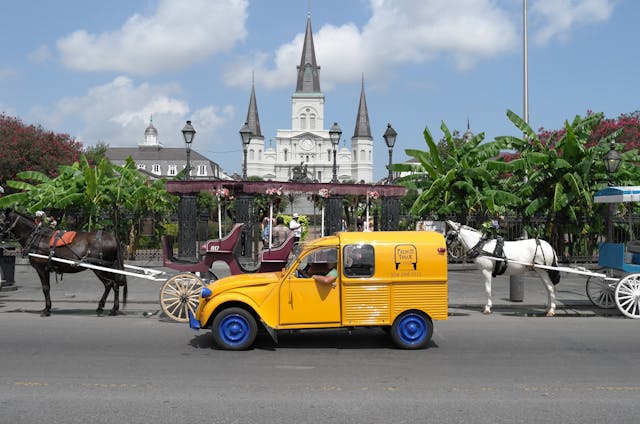
Though he first landed on a H-Van, with plans to operate it like a food truck with a small roaster and coffee shop all on board, he ultimately realized the cost and layout weren’t the right fit. That’s when he spotted an old 2CV Truckette on the lot, and something clicked. He began roasting out of his laundry room and using the eponymous french truck solely as a delivery vessel, all of which seems to have been the right move. French Truck Coffee now has 10 locations and a fleet of 7 bright yellow Citroëns.
And while Meeker notes that French cars as a whole are fairly rare in the city, a phenomenon he attributes to the fact that the area’s French influence predates cars, he still feels the vintage charm was a vital component to his success (alongside, of course, delicious, fresh coffee). “New Orleanians loved the charm and the service of this little truck zipping around town … They are also very proud of their city and their culture. We seemed to have hit the right note for them to embrace us as their own.”

